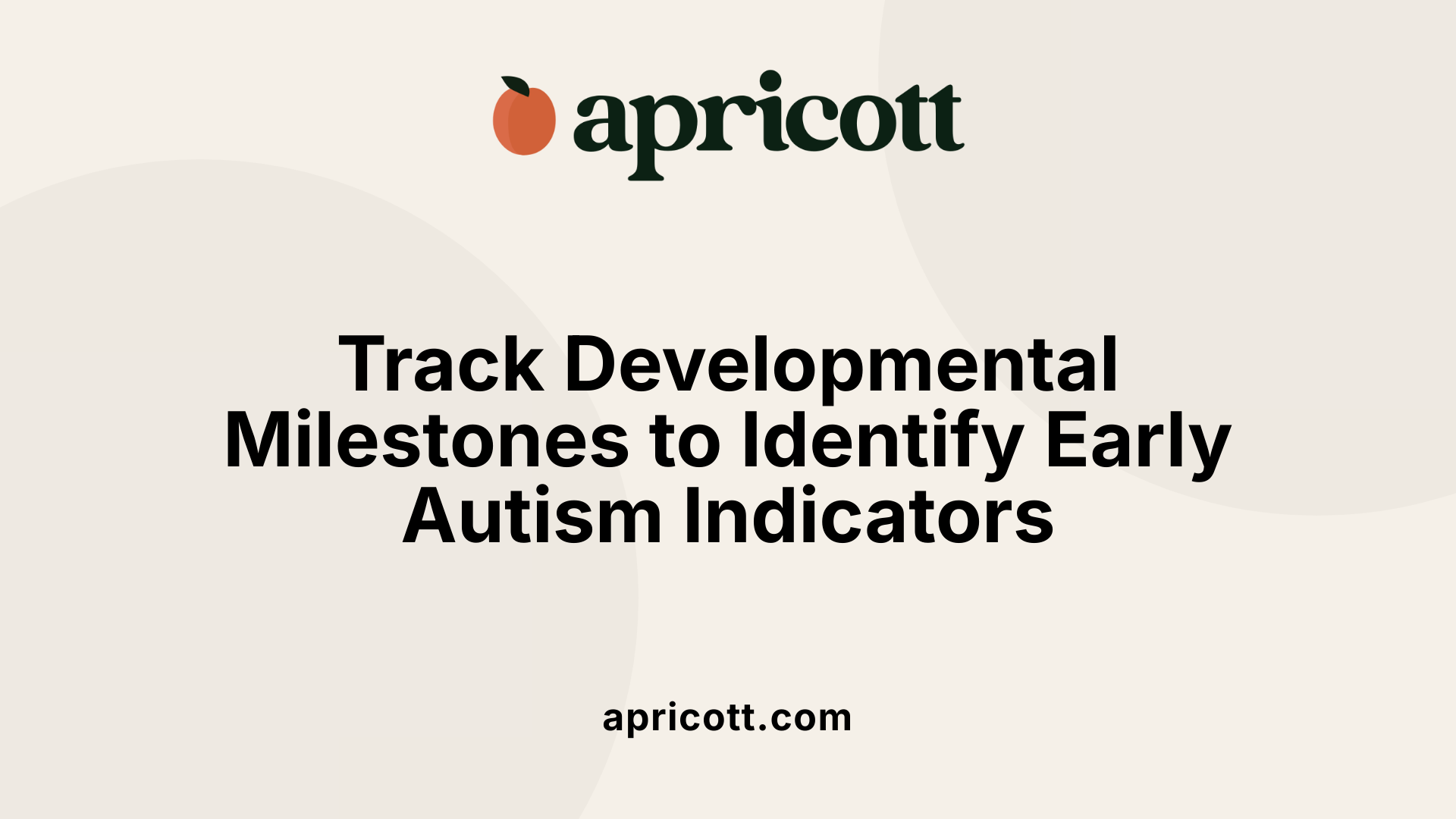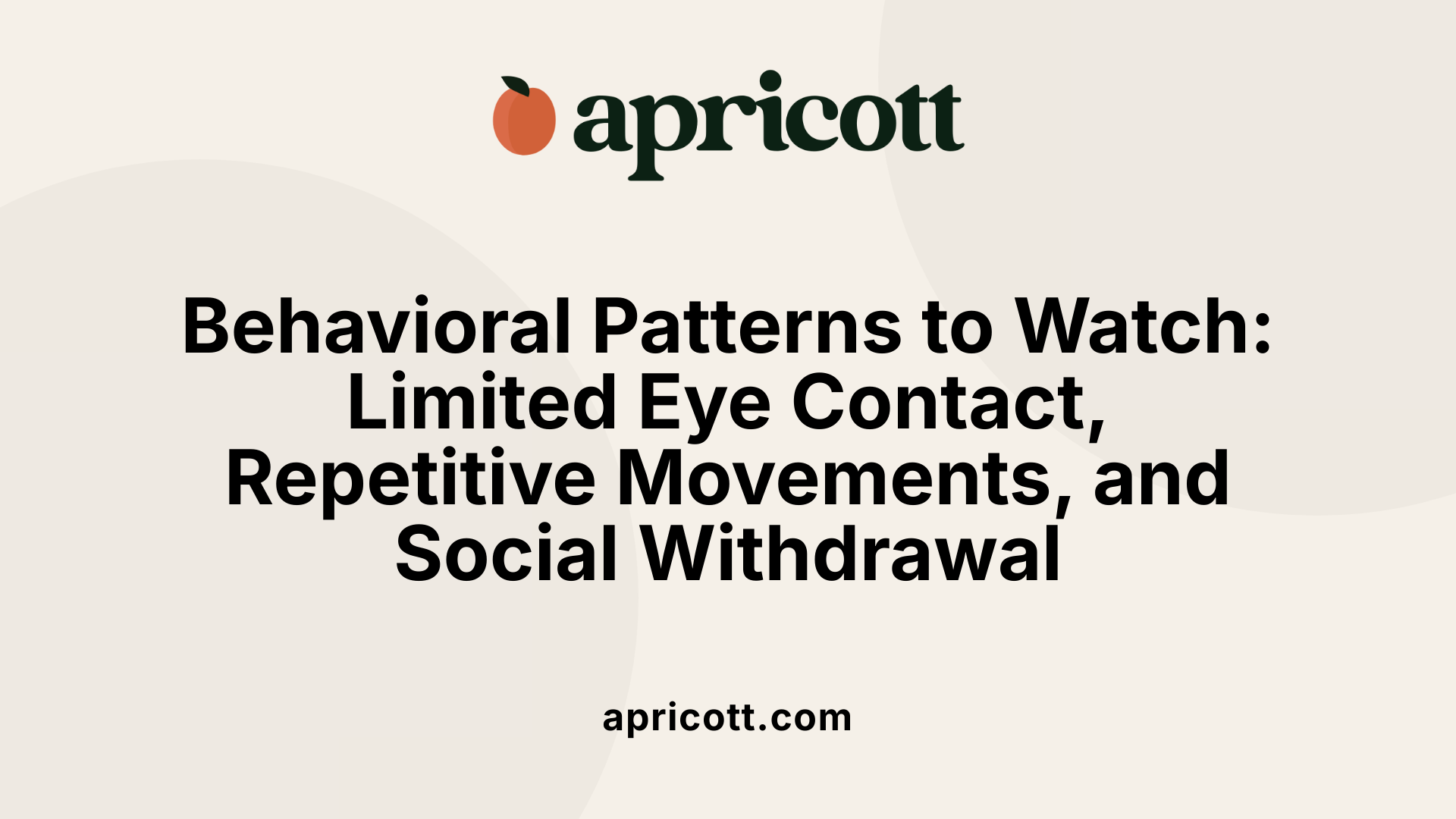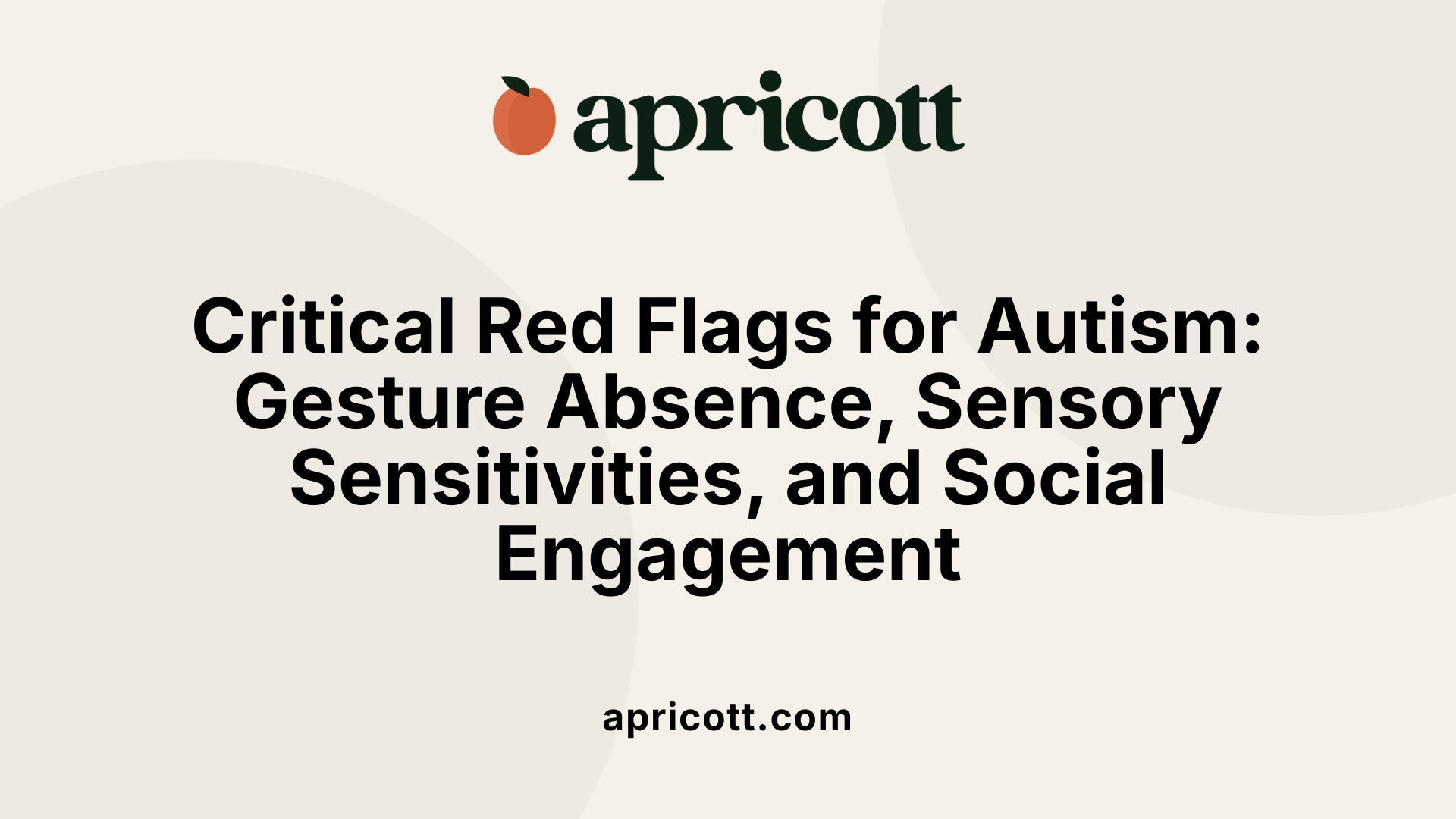July 29, 2025
Recognizing Autism Early: Key Indicators in Infants and Young Children
Early detection of autism spectrum disorder (ASD) is crucial for accessing intervention services that can significantly improve a child's developmental trajectory. Parents and caregivers are often the first to notice potential signs of autism, which may appear as early as six months. This article highlights the developmental markers, behavioral signs, and screening recommendations to help identify autism as early as possible.

Early identification of autism can be challenging but recognizing certain behaviors at a young age helps in early intervention. In infants as young as 6 months, signs may include a noticeable lack of eye contact, which means the baby does not often look at caregivers or follow their gaze. Limited social smiling is another indicator; the baby may not smile in response to social interactions or familiar faces.
Responses to their name are crucial developmental milestones. If a baby does not turn or look towards a parent or caregiver calling their name by 9 months, it could signal a need for further assessment. Babbling delays are also common; by around 16 months, most children begin to combine sounds and words, but children with autism may produce very few or no meaningful sounds or phrases.
Physical movements can reveal signs too. Repetitive body movements like hand-flapping, rocking, or unusual hand motions may be observed. These behaviors often serve as self-stimulation or expressions of excitement. Sensory sensitivities are also common; children might react intensely to sounds, textures, or tastes—overreacting or showing indifference to sensory input.
All these early signs are not definitive for autism but warrant consulting a healthcare professional. Early diagnosis can lead to targeted therapies that significantly improve developmental outcomes.
| Sign or Behavior | Typical Age of Appearance | Description | Additional Notes |
|---|---|---|---|
| Lack of eye contact | 0-12 months | Not making eye contact or following gaze | Can impact social engagement |
| Limited social smiling | 6-12 months | Rarely smiling in social situations | A sign of social interest difficulties |
| Response to name | 6-12 months | Not responding when called | Expected response by 9 months |
| Babbling delays | 4-12 months | Fewer sounds or no babbling | Typically starts around 4-6 months |
| Repetitive body movements | 6-12 months | Hand-flapping, rocking, unusual gestures | Self-stimulation behaviors |
| Sensory sensitivities | 0-12 months | Over- or under-reacting to sensory stimuli | Includes sights, sounds, textures |
Observing these signs early allows for timely support. If concerns arise, parents should consult healthcare providers for appropriate screening and intervention strategies.
For more detailed information on recognizing early signs, parents can search for "early signs of autism in babies 0-12 months." Early detection provides the best chance for effective assistance and development support.

Monitoring early developmental milestones can help identify signs of autism spectrum disorder (ASD). For infants, some positive signs include smiling socially by 6 months, which indicates developing social engagement. By 9 months, most babies will respond to their name, showing recognition and interaction.
As children grow, language skills become more prominent indicators. Babbling, such as repetitive sounds, usually appears by 12 months. If a child does not babble or make repeated consonant sounds, it could be an early sign of ASD. By 24 months, most children typically use two-word phrases like "more juice" or "go park." Children with ASD might show delays or might not combine words at all, which is noteworthy.
Motor skill development also plays a role. Typical milestones include sitting, crawling, walking, and climbing, usually within the first year. Delays in these areas, such as not walking by 18 months or difficulty climbing stairs, can be red flags.
Repetitive behaviors are common early signs. This includes engaging in motions like hand-flapping, rocking, or lining up toys repeatedly. Such behaviors often indicate sensory sensitivities or restricted interests associated with ASD.
Additional signs include limited sharing of interests, such as not pointing to objects to show interest, and atypical responses to sensory input, like intense reactions to sounds or textures.
Fundamentally, children with ASD may exhibit delays in social communication — such as making little or no eye contact, not sharing enjoyment, or showing little interest in social play. Recognizing these signs during routine checkups and developmental screenings can prompt timely assessments.
To sum up, typical milestones and signs relevant for ASD include:
| Age | Typical Milestone | Potential Red Flag in ASD | Additional Notes |
|---|---|---|---|
| 6 months | Social smiling, eye contact | No social smiling or eye contact | Early social engagement cues |
| 9 months | Responds to name | No response to name | Indicates social attention levels |
| 12 months | Babbling, gestures like pointing | Little or no babbling, gestures lacking | Speech and social communication development |
| 18 months | Using words, combining gestures | No words, limited gestures | Motor and language development milestones |
| 24 months | Two-word phrases, build simple sentences | No two-word phrases | Key language milestone; delays suggest screening needed |
| 2-3 years old | Imitation, play with peers | Limited or no interest in peer interaction | Social engagement with other children |
| 3 years and older | Sharing objects, engaging in routines | Strict routines, difficulty adapting | Repetitive behaviors and resistance to change |
Being aware of these milestones and red flags allows parents and caregivers to seek early evaluation. If concerns are identified, consulting a healthcare professional can lead to early diagnosis and intervention. Such steps often improve learning, communication, and social skills in children with ASD.
For more information, parents can explore resources like 'The Spectrum,' a guide that offers strategies, understanding, and support tailored for families. Remember, early action can make a substantial difference in developmental outcomes.

Recognizing early behavioral patterns can be crucial in identifying autism in young children. Some of the most noticeable signs include limited eye contact, where a child might avoid looking directly at people or objects. They may also have difficulty responding to their name, even after repeated calls. These behaviors are often accompanied by a preference for solitude, with children choosing to play or interact alone, showing little interest in engaging with others.
Children with autism frequently exhibit unusual reactions to sensory stimuli. They might be overly sensitive or, conversely, under-responsive to sounds, textures, tastes, or lights. For instance, a child may react intensely to certain noises or textures or seem indifferent to stimuli that typically attract attention.
Repetitive behaviors are also common and include hand-flapping, rocking, spinning objects, or lining up toys in a specific order. These movements can serve as self-stimulation or comfort mechanisms. Echolalia, or the repetition of phrases or sounds, is another typical sign, especially delayed or abnormal language use.
Limited gestures are often observed, such as not pointing, showing, or waving, which are important for social communication. When gestures are used, they may appear odd or inappropriately timed.
Overall, children with autism may demonstrate intense interests in particular topics or objects, struggle to understand social cues like facial expressions or body language, and have emotional reactions that do not seem to match the context.
Early identification of these behavioral signs enables parents and caregivers to seek professional evaluations. Healthcare professionals, such as pediatricians or specialists trained in autism assessment, can then conduct thorough behavioral observations and determine if early intervention services are needed.
Understanding these behavioral patterns helps in supporting children on the spectrum by implementing strategies that improve their social, communication, and behavioral skills. Prompt action can significantly influence their developmental trajectory and quality of life.

In the early stages of childhood, certain behaviors can serve as warnings of autism spectrum disorder (ASD). Key signs include the absence of typical gestures such as waving, pointing, or showing objects to others. These gestures help children communicate and share experiences, so their absence may signal social communication challenges.
Another critical indicator is no response to their name being called. Usually, by nine months, children will turn towards voices or sounds, but children with ASD may ignore their names consistently.
Repetitive behaviors are also common early signs. These can include flapping hands, rocking back and forth, lining up toys, or spinning objects repeatedly. Such actions often serve as self-stimulatory behaviors and are characteristic of the restricted interests seen in ASD.
Limited social interest is another red flag. Children who show little or no interest in engaging with others, avoid eye contact, and do not enjoy social play might be displaying early signs of autism.
Sensory sensitivities are also telling. Some children display heightened reactions, such as distress to loud noises or bright lights, while others may seem unaffected or may not respond to pain or temperature changes adequately.
Another important signal is regression of skills. Some children initially develop speech or social skills but then lose these abilities later, which can be a very concerning sign.
The most significant red flag indicating autism is impairment in social interaction. This includes a lack of eye contact, failure to respond when called by name, and difficulty sharing interests through gestures like showing or pointing. Early signs often involve minimal or absent reciprocal social behaviors such as smiling when others smile at them or engaging in back-and-forth communication.
Delayed or absent speech development also emphasizes the suspicion. By 12 months, many children start babbling; children with autism, however, often show little or no babbling or meaningful two-word phrases by age two.
Repetitive behaviors and resistance to routine changes further support early detection. Recognizing these signs enables families and healthcare professionals to pursue early assessment and intervention options.
| Behavior | Typical Development | Autism Spectrum Traits | Explanation |
|---|---|---|---|
| Lack of gestures | Pointing, reaching, waving to share interest | Little to no gesturing or odd gesture use | Restricts social communication skills |
| Not responding to their name | Turns towards sounds or voices | No response past age 9 months | Indicates social awareness delay |
| Repetitive movements | Occasional hand movements or rocking | Hand-flapping, spinning, or lining up objects | Self-stimulatory behaviors suggest difficulty in processing sensory input |
| Limited social interest | Enjoys social play, makes eye contact | Avoids eye contact, prefers solitude | Reflects challenges in social interactions |
| Sensory over- or under-reactivity | Slight reactions to sensory input | Extreme reactions or indifference to stimuli | Sensory processing differences contribute to behavioral challenges |
| Regression of skills | Maintains language and social skills | Loses previously acquired skills | A concerning sign often arising around 15-24 months |
If these signs are observed, it is crucial to consult healthcare professionals such as pediatricians or specialists trained in autism diagnosis. Early intervention can significantly improve developmental outcomes.
The American Academy of Pediatrics recommends autism screening at 18 and 24 months, in addition to ongoing developmental monitoring during regular checkups.
For additional support, parents can explore resources like 'The Spectrum' guide, which offers practical strategies and information on understanding autism, diagnosis, and support options.
While diagnosis is based on behavioral assessment rather than biological testing, early recognition and intervention make a notable difference in helping children develop communication, social, and adaptive skills.
Autism spectrum disorder (ASD) is a relatively common neurodevelopmental condition that affects social communication, behavior, and interests. It is estimated that 1 in 44 children in the United States are diagnosed with autism, highlighting its prevalence.
The causes of autism are complex and multifaceted. Research shows that genetic influences play a dominant role, with estimates indicating that between 60 to 90% of the risk is inherited through gene mutations and variations. These genetic factors can influence how the brain develops and functions.
In addition to genetics, environmental factors during pregnancy and early childhood can increase the likelihood of autism. These include advanced parental age at conception, prenatal exposure to pollutants like air pollution or pesticides, maternal obesity, diabetes, and immune disorders. Complications at birth such as prematurity or oxygen deprivation can also be contributing factors.
These environmental influences may impact brain development by disrupting gene networks, neural communication pathways, and interactions among different brain regions, ultimately affecting early brain architecture and connectivity.
A common misconception is that vaccines cause autism. Extensive scientific studies have thoroughly investigated this claim. The consensus among health experts and research organizations, including the Centers for Disease Control and Prevention (CDC), is that vaccines are not linked to autism.
Overall, autism arises from an intricate interplay between genetic predispositions and environmental exposures that influence the developing brain, leading to the diverse range of characteristics observed in individuals on the spectrum.
| Factor | Description | Impact on Autism Risk |
|---|---|---|
| Genetic influences | Gene mutations and variations inherited through families | Major contributor to risk |
| Environmental factors | Prenatal and early childhood exposures such as pollution, maternal health issues | Modulate risk, influence brain development |
| Birth complications | Prematurity, oxygen deprivation | Can increase susceptibility |
| Vaccinations | No scientific evidence links vaccines to autism | No association |
Understanding these causes helps in early detection and intervention, which can significantly improve developmental outcomes for children on the spectrum.
Recognizing the early signs of autism is vital for timely intervention and support. By understanding the developmental markers and behavioral patterns discussed above, parents, caregivers, and health professionals can work together to ensure children receive the help they need at the earliest possible stage. Regular screening during well-child visits, such as those recommended at 18 and 24 months, alongside developmental milestone checklists like The Spectrum, empower families to identify concerns early. Early diagnosis and intervention can significantly improve communication skills, social engagement, and overall developmental outcomes, opening doors to a richer, more engaged life for children on the autism spectrum.